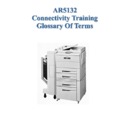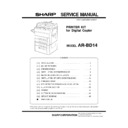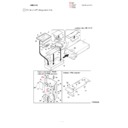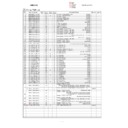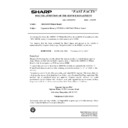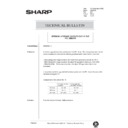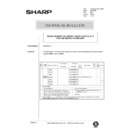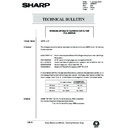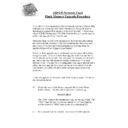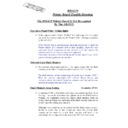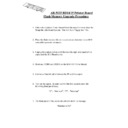Sharp AR-BD14 (serv.man3) Handy Guide ▷ View online
&OLHQW
A PC that requests information from a File Server.
&60$&$&DUULHU6HQVH0XOWLSOH$FFHVV:LWK&ROOLVLRQ$YRLGDQFH
In CSMA/CA each computer signals its intent to transmit before it actually transmits
data. In this way computers sense when a collision might occur and may avoid
transmission collisions. Broadcasting this intent however increases network traffic
and so slows down network performance. For this reason CSMA/CA is not as popular
as CSMA/CD. Apple Macintosh computers use CSMA/CA when connecting together
with LocalTalk
data. In this way computers sense when a collision might occur and may avoid
transmission collisions. Broadcasting this intent however increases network traffic
and so slows down network performance. For this reason CSMA/CA is not as popular
as CSMA/CD. Apple Macintosh computers use CSMA/CA when connecting together
with LocalTalk
&60$&'&DUULHU6HQVH0XOWLSOH$FFHVV:LWK&ROOLVLRQ'HWHFWLRQ
The method whereby Ethernet and 802.3 stations transmit onto a network. The
stations monitor the network and if no activity is sensed, begin to transmit. They
continue to monitor, and should multiple stations have tried to access the cable at
once, they’ll sense a collision, cease transmission, wait a random time and then try
again.
stations monitor the network and if no activity is sensed, begin to transmit. They
continue to monitor, and should multiple stations have tried to access the cable at
once, they’ll sense a collision, cease transmission, wait a random time and then try
again.
'H6SRROLQJ
The sequence where the print server removes (Polls) a print job from the print queue
and forwards the print job to the printer.
and forwards the print job to the printer.
(3520(UDVDEOH3URJUDPPDEOH5HDG2QO\0HPRU\
Pronounced “ee-prom”. A special type of ROM (Read Only Memory) that can be
erased by high intensity ultraviolet (UV) light and then rewritten, or reprogrammed.
EPROM chips usually contain UV-permeable quartz windows exposing some of the
chips internal components.
erased by high intensity ultraviolet (UV) light and then rewritten, or reprogrammed.
EPROM chips usually contain UV-permeable quartz windows exposing some of the
chips internal components.
(WKHUQHW
A networking specification that first appeared in a modern form in the early 1980’s.
It was developed by Digital, Xerox and Intel. It describes the type of data frame that
can be sent over a network and the methods used to manage data collisions. It is
similar, but not identical to the IEEE 802.3 specification.
It was developed by Digital, Xerox and Intel. It describes the type of data frame that
can be sent over a network and the methods used to manage data collisions. It is
similar, but not identical to the IEEE 802.3 specification.
(PXODWLRQ
The process by which a piece of equipment behaves like other equipment (Of another
Make).
Make).
)DVW(WKHUQHW
A variant of standard Ethernet cable however Fast Ethernet runs at 100 Mbps rather
than 10 Mbps as with standard Ethernet.
than 10 Mbps as with standard Ethernet.
)LOH6HUYHU
Also known as a server, this is a central computer that supplies services to other PC’s
(Clients) connected to a network. This term is also used to describe a file server type
of network in which the server only holds data and the processing of the data is done
at each workstation.
(Clients) connected to a network. This term is also used to describe a file server type
of network in which the server only holds data and the processing of the data is done
at each workstation.
)ODVK0HPRU\
Flash Memory is an alternative to using an “EPROM”. Instead of having a physical
device that must be changed as with an “EPROM”, Flash Memory comes in a data file
format. The file contains the content of the flash memory. The file is downloaded by a
computer to the device, in our case the AR5132. During the download, the data file is
written into the memory of the device, the flash memory then becomes permanent.
Both the Printer Board and the network card for the AR5132 include a Flash Memory.
device that must be changed as with an “EPROM”, Flash Memory comes in a data file
format. The file contains the content of the flash memory. The file is downloaded by a
computer to the device, in our case the AR5132. During the download, the data file is
written into the memory of the device, the flash memory then becomes permanent.
Both the Printer Board and the network card for the AR5132 include a Flash Memory.
)UDPH
A group of bytes sent over a network, including control and address information.
)UDPH7\SH
Frame Types determine how packets of network data are formatted on different local
area networks. Ethernet and Token Ring use different formats of frame type.
area networks. Ethernet and Token Ring use different formats of frame type.
)73)LOH7UDQVIHU3URWRFRO
A system of sending files across a TCP/IP network. FTP is part of the TCP/IP
protocol stack and is only available for use when the TCP/IP protocol is loaded.
protocol stack and is only available for use when the TCP/IP protocol is loaded.
*DWHZD\
A Gateway allows different systems to talk to each other. It is a system that transfers
network data between network types, translating the data between the two types as
needed. Although there is a Gateway setting within the AR5132’s Control Panel
Menu, the network card does not support this function. Because of this, the Gateway
Address does not need to be set on the copier.
network data between network types, translating the data between the two types as
needed. Although there is a Gateway setting within the AR5132’s Control Panel
Menu, the network card does not support this function. Because of this, the Gateway
Address does not need to be set on the copier.
+RVW
A networked computer.
+8%
This is a central point of larger networks. A type of junction box. Hubs come in
various degrees of sophistication and size ranging from simple products providing just
the electrical functions for small networks of less than eight users, to focal points for
large corporate networks.
various degrees of sophistication and size ranging from simple products providing just
the electrical functions for small networks of less than eight users, to focal points for
large corporate networks.
,(((
On March 30
th
1994, the IEEE Standards Board approved its parallel port standard.
Before the IEEE 1284 standard, parallel ports came in many differing shapes and
sizes, although there were four main types: Standard Parallel Ports, Bi-directional
Parallel Ports, Enhanced Parallel Ports and Extended Capabilities Ports. The IEEE
1284 standard redefined the differences in the ports, classifying them by the transfer
mode that they use. It also describes the physical and electrical characteristics of each
type of port.
sizes, although there were four main types: Standard Parallel Ports, Bi-directional
Parallel Ports, Enhanced Parallel Ports and Extended Capabilities Ports. The IEEE
1284 standard redefined the differences in the ports, classifying them by the transfer
mode that they use. It also describes the physical and electrical characteristics of each
type of port.
,3$GGUHVV
An IP Address is a logical 32-bit address that is used to identify a TCP/IP device. If
the TCP/IP protocol is used on a network, an IP Address will have to be set-up for
every device on that network.
the TCP/IP protocol is used on a network, an IP Address will have to be set-up for
every device on that network.
The AR-5132 will require an IP Address if it is used on a network that is running the
TCP/IP Protocol. The IP Address can be assigned to the copier by the technician
from the machines Printer Board Control Panel Menu. Alternatively, the customer
can set the IP Address for the copier using either the Printset Utility Software that is
included with the Network Card or through a DOS command called “ARP”.
TCP/IP Protocol. The IP Address can be assigned to the copier by the technician
from the machines Printer Board Control Panel Menu. Alternatively, the customer
can set the IP Address for the copier using either the Printset Utility Software that is
included with the Network Card or through a DOS command called “ARP”.
/$1/RFDO$UHD1HWZRUN
A network that is used within a geographical area e.g. an office or building and
interconnects a variety of computers, terminals and PC’s.
interconnects a variety of computers, terminals and PC’s.
/RFDO7DON
LocalTalk refers to the cables and connectors used within an AppleTalk network on
Apple Macintosh computers. Because of the slow speed of LocalTalk, it is limited to
the number of devices that can be connected. Over the years, LocalTalk has become
too slow for graphics and colour image intensive applications, and so users have
moved to Ethertalk. LocalTalk uses CSMA/CA as an access method in a bus or tree
topology with Shielded Twisted Pair (STP), Unshielded Twisted Pair (UTP) or even
Fibre Optic Cable.
Apple Macintosh computers. Because of the slow speed of LocalTalk, it is limited to
the number of devices that can be connected. Over the years, LocalTalk has become
too slow for graphics and colour image intensive applications, and so users have
moved to Ethertalk. LocalTalk uses CSMA/CA as an access method in a bus or tree
topology with Shielded Twisted Pair (STP), Unshielded Twisted Pair (UTP) or even
Fibre Optic Cable.
0DF1RGH$GGUHVV
The MAC or Node Address is a specific address that is programmed into every
network card within the world. As this address is different for every network card, it
is used by many protocols for determining where data should be sent across a network
and from where it originated.
network card within the world. As this address is different for every network card, it
is used by many protocols for determining where data should be sent across a network
and from where it originated.
1HWZRUN2SHUDWLQJ6\VWHP126
An Operating System, such as Novell’s Netware or Microsoft’s Windows NT Server.
They provide basic file system services and supervisory functions to computers
connected to a network.
They provide basic file system services and supervisory functions to computers
connected to a network.
1,&1HWZRUN,QWHUIDFH&DUG
A circuit board that is installed into workstations, file servers and some printers to
allow them to communicate on a network. The NIC puts data on and takes data off
the network cable.
allow them to communicate on a network. The NIC puts data on and takes data off
the network cable.
2SHUDWLQJ6\VWHP
The resident master control program in a computer system such as Windows 95 or NT
Workstation that provides for the exchange of information between all parts of the
computer.
Workstation that provides for the exchange of information between all parts of the
computer.

